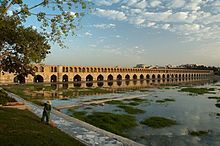Si-o-se-pol
| Si-o-se-pol | |
|---|---|
 |
|
| Coordinates | 32°38′40″N 51°40′03″E / 32.64444°N 51.66750°ECoordinates: 32°38′40″N 51°40′03″E / 32.64444°N 51.66750°E |
| Crosses | Zayanderud |
| Locale | Isfahan, Iran |
| Characteristics | |
| Design | Arch bridge, double-deck |
| Material | Stone and bricks |
| Total length | 297.76 metres (976.9 ft) |
| Width | 13.75 metres (45.1 ft) |
| Longest span | 5.60 metres (18.4 ft) |
| No. of spans | 33 |
| History | |
| Construction start | 1599 |
| Construction end | 1602 |
The Allahverdi Khan Bridge (Persian: پل اللهوردیخان), popularly known as Si-o-se-pol (Persian: سیوسهپل, lit. '[the] bridge of thirty-three [spans]'), is one of the eleven bridges in Isfahan, Iran. It is the longest bridge on the Zayanderud, with a total length of 297.76 metres (976.9 ft), and is one of the most famous examples of Safavid bridge design.
Built between 1599 and 1602, the construction was financed and supervised by the Georgian chancellor of Abbas I, Allahverdi Khan Undiladze. It consists of two superimposed rows of 33 arches. There is a larger base plank at the start of the bridge, under which the Zayanderud flows, supporting a tea house, which is nowadays abandoned.
A 17th-century drawing of Si-o-se-pol by Jean Chardin.
Benches and tables next to Si-o-se-pol.
Si-o-se-pol's down floor.
Si-o-se-pol in December 2015.
Under a row of the arches of Si-o-se-pol.
The statue of Allahverdi Khan, next to the bridge.
Si-o-se-pol at night.
Si-o-se-pol's walkway at night.
...
Wikipedia

